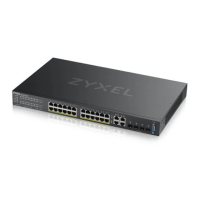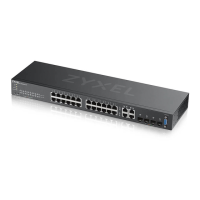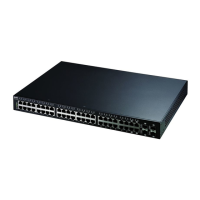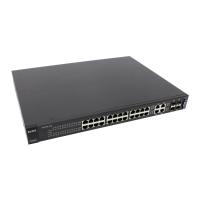Chapter 22 Policy Rule
GS2220 Series User’s Guide
218
General
VLAN ID Specify a VLAN ID.
Egress Port Type the number of an outgoing port.
Priority Specify a priority level.
Rate Limit You can configure the desired bandwidth available to a traffic flow. Traffic that exceeds the
maximum bandwidth allocated (in cases where the network is congested) is called out-of-profile
traffic.
Bandwidth Specify the bandwidth in kilobit per second (kbps). Enter a number between 1 and 1000000.
Action
Specify the actions the Switch takes on the associated classified traffic flow.
Note: You can specify only one action (pair) in a policy rule. To have the Switch take multiple actions
on the same traffic flow, you need to define multiple classifiers with the same criteria and apply
different policy rules.
Say you have several classifiers that identify the same traffic flow and you specify a different policy rule for each. If
their policy actions conflict (Disc a rd the pa c ke t, Se nd the pa c ke t to the e g re ss po rt and Ra te Limit), the Switch only
applies the policy rules with the Disc a rd the pa c ke t and Se nd the pa c ke t to the e g re ss po rt actions depending on
the classifier names. The longer the classifier name, the higher the classifier priority. If two classifier names are the
same length, the bigger the character, the higher the classifier priority. The lowercase letters (such as a and b)
have higher priority than the capitals (such as A and B) in the classifier name. For example, the classifier with the
name of class 2, class a or class B takes priority over the classifier with the name of class 1 or class A.
Let’s say you set two classifiers (Class 1 and Class 2) and both identify all traffic from MAC address 11:22:33:44:55:66
on port 3.
If Policy 1 applies to Class 1 and the action is to drop the packets, Policy 2 applies to Class 2 and the action is to
forward the packets to the egress port, the Switch will forward the packets.
If Policy 1 applies to Class 1 and the action is to drop the packets, Policy 2 applies to Class 2 and the action is to
enable bandwidth limitation, the Switch will discard the packets immediately.
If Policy 1 applies to Class 1 and the action is to forward the packets to the egress port, Policy 2 applies to Class 2
and the action is to enable bandwidth limitation, the Switch will forward the packets.
Forwarding Select No c ha ng e to forward the packets.
Select Disc a rd the pa c ke t to drop the packets.
Priority Select No c ha ng e to keep the priority setting of the frames.
Select Se t the pa c ke t’s 802.1p prio rity to replace the packet’s 802.1p priority field with the value
you set in the Prio rity field.
Queue Select No c ha ng e to follow the priority queue setting in Ba sic Se tting > Switc h Se tup > Prio rity
Q ue ue A ssig nme nt.
Select Se nd the p a c ke t to prio rity que ue to send the packet to the specific priority queue with
the value you set in the Prio rity field.
Outgoing Select Se nd the p a c ke t to the mirror po rt to send the packet to the mirror port.
Select Se nd the p a c ke t to the e g re ss po rt to send the packet to the egress port.
Select Se t the pa c ke t's VLAN ID to set the packet’s VLAN ID.
Rate Limit Select Ena b le to activate bandwidth limitation on the traffic flows then set the actions to be
taken on out-of-profile packets.
Add Click Add to inset the entry to the summary table below and save your changes to the Switch’s
run-time memory. The Switch loses these changes if it is turned off or loses power, so use the Sa ve
link on the top navigation panel to save your changes to the non-volatile memory when you are
done configuring.
Table 94 Advanced Application > Policy Rule (continued)
LABEL DESCRIPTIO N

